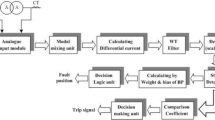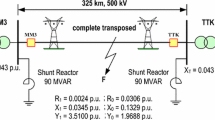Abstract
In this paper, in order to locate the fault in the transmission network, a discrete wavelet transform is used to extract the fault characteristics from the zero-sequence current, in order to train the artificial neural network. In fact, the basis of the work is based on the information recorded after the fault at the beginning and at the end of the line, received by the relay. In the following, with the help of Fortescue’s transform, the current of zero sequence seen from both terminals is calculated and by the transform of the wavelet of stored information at high frequency is extracted in the horizontal components of the zero sequence current from both terminals, and finally calculating the energy stored in horizontal components, as well as extracting the maximum scales of horizontal components can reveal certain features of the fault that are suitable for training the neural network. Simulation results show that the maximum scales of horizontal components and the energy stored in these components strongly depend on the fault resistance, type of fault, fault angle and fault location. Therefore, the training data should be selected in such a way that these changes are well represented so that the neural network does not encounter problem in its diagnosis. Finally, the proposed method has been tested on a transmission network of 735 kV at different distances of the transmission line. And results indicate that the proposed algorithm can estimate fault distance depending on the type of fault in different conditions.
















Similar content being viewed by others
REFERENCES
De Andrade, L., De Leão, and Ponce, T., Impedance based fault location analysis for transmission lines, Transmission and Distribution Conference and Exposition (T&D),IEEE PES, 2012.
Masoud Dashtdar, Rahman Dashti, and Hamid Reza Shaker, Distribution network fault section identification and fault location using artificial neural network, 2018 5th International Conference on Electrical and Electronic Engineering (ICEEE), 2018.
Masoud Dashtdar, Fault location in distribution network based on fault current analysis using artificial neural network, J. Electr. Comput. Eng., 2018, vol. 1, no. 2, pp. 18–32.
Majid Dashtdar and Masoud Dashtdar, Fault location in the transmission network using a discrete wavelet transform, Am. J. Electr. Comput. Eng., 2019, vol. 3, no. 1, pp. 30–37.
Lopes, F.V., Kusel, B.F., and Silva, K.M., Traveling wave-based fault location on half-wavelength transmission lines, IEEE Latin Am. Trans., 2016, vol. 14, no. 1.
Bo, Z.Q., Weller, G., and Redfern, M.A., Accurate fault location technique for distribution system using fault-generated high-frequency transient voltage signals, IEE Proc. Gener. Transm. Distrib., 1999, vol. 146, no. 1, pp. 73–79.
Rao, A. and Bogale, B., Accurate fault location technique on power transmission lines with use of phasor measurements, Int. J. Eng. Res. Technol., 2015, vol. 4, no. 2.
Xu, Z. and Zhang, Z., What accuracy can we expect from the single-ended fault locator?, 2015 68th Annual Conference for Protective Relay Engineers, 2015.
Venugopal, M. and Tiwari, C., A novel algorithm to determine fault location in a transmission line using PMU measurements, 2013 IEEE International Conference on Smart Instrumentation, Measurement and Applications (ICSIMA), 2013.
Elkalashy, N.I., Kawady, T.A., Khater, W.M., and Taalab, A.M., Unsynchronized fault-location technique for double-circuit transmission systems independent of line parameters, IEEE Trans. Power Delivery, 2015.
Gaurav Kapoor, A fault-location evaluation method of a 330 kV three-phase transmission line by using discrete wavelet transform, Int. J. Eng. Des. Anal., 2018, vol. 1, no. 1, pp. 5–10.
Magnago, F.H. and Abur, A., Fault location using wavelet, IEEE Trans. Power Delivery, 1998, vol. 13, no. 4, pp. 1475–1480.
Samantaray, S.R., Panigrahi, B.K., and Dash, P.K., High impedance fault detection in power distribution networks using time-frequency transform and probabilistic neural network, IET Gener. Transm. Distrib., 2008, vol. 2, no. 2, pp. 261–270.
Zhengyou, H., Ling, F., Sheng, L., and Zhiqian, B., Fault detection and classification in EHV transmission line based on wavelet singular entropy, IEEE Trans. Power Delivery, 2010, vol. 25, pp. 2156–2163.
Ekici, S., Yildirim, S., and Poyraz, M., Energy and entropy-based feature extraction for locating fault on transmission lines by using neural network and wavelet packet decomposition, Expert Syst. Appl., 2008, vol. 34, pp. 2937–2944.
Majid Dashtdar and Masoud Dashtdar, Fault location in the transmission network based on the analysis of the recorded current by the relay using a discrete wavelet transform, Am. J. Electr. Comput. Eng., 2019, vol. 3, no. 1, pp. 30–37.
Dashtdar, M. and Dashtdar, M., Fault location in distribution network based on phaser measurement units (PMU), The Scientific Bulletin of Electrical Engineering Faculty, 2019, vol. 19, no. 2, pp. 38–43.
Dashtdar, M. and Dashtdar, M., Detecting the fault section in the distribution network with distributed generators based on optimal placement of smart meters, The Scientific Bulletin of Electrical Engineering Faculty, 2019, vol. 19, no. 2, pp. 28–34.
Dashtdar, M. and Dashtdar, M., Fault location in the transmission network based on extraction of fault components using wavelet transform, The Scientific Bulletin of Electrical Engineering Faculty, 2019, vol. 19, no. 2, pp. 1–9.
Author information
Authors and Affiliations
Corresponding author
Ethics declarations
CONFLICT OF INTEREST
The authors declare that they have no conflicts of interest.
ADDITIONAL INFORMATION
Masoud Dashtdar was born in Bushehr, Iran, on September 20, 1986. He received the M.Sc. in power electrical engineering of Islamic Azad University of Bushehr, Iran, in 2013. he is currently pursuing the Ph.D. degree with Islamic Azad University, Bushehr, Iran. His research interests are distribution system, include fault diagnosis in power systems, neural network computing, power electronics, Electric machines, renewable energy, and harmonic analysis.
About this article
Cite this article
Dashtdar, M., Esmaeilbeig, M., Najafi, M. et al. Fault Location in the Transmission Network Using Artificial Neural Network. Aut. Control Comp. Sci. 54, 39–51 (2020). https://doi.org/10.3103/S0146411620010022
Received:
Revised:
Accepted:
Published:
Issue Date:
DOI: https://doi.org/10.3103/S0146411620010022




